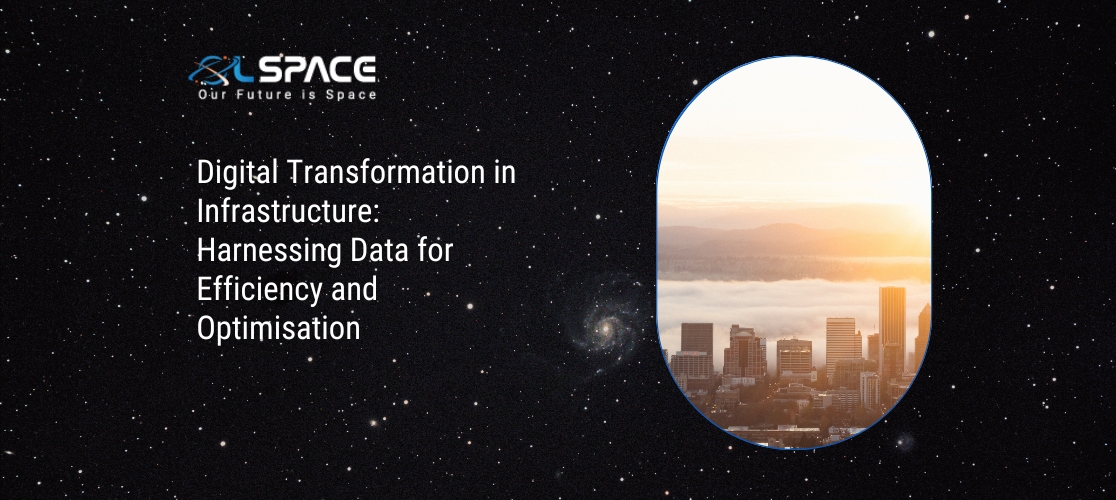15 August 2023
Digital Transformation in Infrastructure: Harnessing Data for Efficiency and Optimisation

The concept of digital transformation has transcended industries, revolutionizing the way businesses operate and deliver value. In the realm of infrastructure, from transportation systems to energy grids, digital transformation is reshaping traditional practices and paving the way for smarter, more efficient, and sustainable solutions. By harnessing the power of data, analytics, and interconnected technologies, infrastructure entities are optimizing operations, enhancing user experiences, and creating a foundation for future growth. In this article, we will explore how digital transformation is driving efficiency and optimization in infrastructure development.
The Digital Transformation Paradigm: Digital transformation in infrastructure involves integrating technology-driven strategies to enhance processes, streamline operations, and improve outcomes. It encompasses a range of technologies including the Internet of Things (IoT), data analytics, artificial intelligence (AI), and cloud computing.
Data-Driven Decision Making: The heart of digital transformation lies in data. By collecting and analyzing real-time data from various sources—sensors, devices, and users—infrastructure stakeholders gain valuable insights. This data-driven approach enables informed decision-making, optimizing maintenance schedules, traffic management, and resource allocation.
Smart Infrastructure Management: IoT devices embedded in infrastructure elements—such as bridges, roads, and utility networks—enable real-time monitoring. This data facilitates predictive maintenance, allowing for timely repairs and minimizing disruptions. For example, sensors on bridges can detect structural issues before they escalate.
Enhanced User Experiences: Digital transformation places users at the center. In transportation, real-time data from GPS and traffic sensors enable travelers to plan routes, avoiding congestion. Smart cities offer mobile apps for parking space availability, public transport schedules, and more, enhancing urban mobility.
Energy Efficiency and Sustainability: Digital technologies optimize energy consumption. Smart grids analyze usage patterns to allocate energy efficiently. Renewable energy sources are integrated seamlessly into the grid, promoting sustainability and reducing carbon footprints.
Supply Chain Optimization: For infrastructure projects, digital tools aid in supply chain management. Drones and AI monitor construction progress, ensuring timely deliveries and identifying potential delays. This real-time oversight prevents bottlenecks and cost overruns.
Infrastructure as a Service (IaaS): Cloud computing enables Infrastructure as a Service, where computing resources are provided over the internet. This approach eliminates the need for heavy physical infrastructure, reducing costs and enhancing scalability.
Risk Mitigation and Safety: Predictive analytics and AI enhance safety protocols. By analyzing historical data and real-time inputs, potential risks in infrastructure elements can be identified and mitigated, ensuring the well-being of users and workers.
Realizing the Vision of Smart Cities: Digital transformation is at the core of creating smart cities—urban areas leveraging technology for sustainability, efficiency, and quality of life. Integrated data systems manage traffic flow, optimize waste management, and enhance public services.
Data Privacy and Security: As infrastructure becomes more digitally connected, ensuring data privacy and cybersecurity becomes paramount. Robust protocols are necessary to safeguard sensitive information and protect against cyber threats.
Conclusion:
Digital transformation is reshaping the infrastructure landscape, creating a new era of efficiency, sustainability, and user-centric solutions. By harnessing data and advanced technologies, infrastructure entities are optimizing operations, enhancing user experiences, and laying the groundwork for a future where cities are smarter, energy is greener, and connectivity is seamless. As this transformation continues, collaboration between governments, industries, and tech innovators will be key to realizing the full potential of a digitally transformed infrastructure ecosystem.
